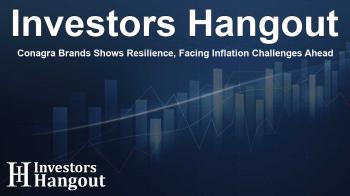Conagra Brands Shows Resilience, Facing Inflation Challenges Ahead

Conagra Brands Inc. Reports Strong Yet Challenging Earnings
Conagra Brands Inc. (NYSE:CAG) recently reported its fiscal first-quarter results, surpassing Wall Street's modest expectations even as their overall sales and profits experienced a decline. The company posted a revenue of $2.63 billion, reflecting a decrease of 5.8% from the previous year. Moreover, their adjusted earnings per share (EPS) dropped by 26.4%, landing at 39 cents. Yet, despite these figures, Conagra’s results still exceeded forecasts, primarily due to timing with trade expenses and favorable mix effects that benefited their financials.
Analyzing Conagra's Current Performance
Conagra reiterated its guidance for organic net sales, predicting a contraction between -1% and +1%. They aim for operating margins within the range of 11.0% to 11.5%, guiding with an estimated EPS of $1.70 to $1.85 for fiscal 2026. However, it is essential to note the pressure arising from inflationary costs, which are anticipated to rise by about 3% due to tariffs, contributing to an overall inflation rate creeping into the low-7% territory.
Main Challenges Ahead for Conagra
While the company remains optimistic, analysts highlight that the path ahead is laden with challenges. Peter T. Galbo, an analyst from Bank of America, maintained an Underperform rating for Conagra, projecting a price target of $18, valuing the company at ten times his fiscal year 2026 EPS estimate. He expressed concern that the initial earnings beat may stem from temporary benefits that are likely to dissipate in the upcoming quarter. Trade accrual reversals alongside the heightened costs of protein and chicken, as well as tariff consequences, create a scenario where margins might falter below 11.0%.
Future Profitability and Market Position
Additional observations from Galbo pointed out potential distortions due to merchandising shifts, particularly in products like Marie Callender’s frozen meals, which could further complicate near-term performance assessments.
Outlook from RBC Capital
Complementarily, RBC Capital's Nik Modi reiterated a Sector Perform rating with a $22 price forecast, underlined by an EPS estimate of $1.73 for fiscal 2026 and a DCF valuation anticipating a 1% revenue compound annual growth rate. Modi revised his EPS projection slightly from $1.74 to $1.73, but identified an organic sales decline of only 0.6%, an improvement from the expected contraction of 1.9%. Even when excluding a trade timing benefit, sales performance remained above expectations, indicating stronger-than-anticipated service levels at 98% across Conagra's product portfolio.
Financial Stability and Market Challenges
Despite these optimistic indicators, Modi emphasized that the company is still faced with headwinds, including consumer apprehension and the ongoing struggle with rising protein costs that threaten to impact growth trajectories in the latter half of the fiscal year. Both analysts maintained a watchful eye on the dividend payout ratio, projected near 80%, where ideally, it should hover around 50% to 55%.
Navigating Inflation and Tariffs
In light of inflationary pressures, tariffs, and the reversal of early-quarter benefits, analysts caution that Conagra's reaffirmation of guidance may not be as stable as hoped. Stakeholders await evidence of consistent volume recovery and improved productivity, essential for restoring confidence in long-term margin profitability.
Conagra's Strategic Response
The valuation range between $18 on the bearish end and $22 for a neutral position underlines the importance for Conagra to stabilize its volumes, control costs effectively, and optimize its performance in frozen and snack product categories. In the balance, while Conagra has indicated a readiness to tackle these adversities, the coming months will be crucial in determining how well the company manages inflation, responds to tariff implications, and adapts to consumer sentiment.
Frequently Asked Questions
What were Conagra's most recent earnings results?
Conagra reported a revenue of $2.63 billion, a decrease of 5.8% from the previous year, with an adjusted EPS of 39 cents.
How do analysts view Conagra's outlook?
Analysts express mixed opinions, with some projecting a stabilizing outlook while others are cautious due to inflation and cost pressures impacting margins.
What price targets have analysts set for Conagra stock?
Analysts set a price target range between $18 to $22 for Conagra, reflecting their differing views on the company’s future performance.
What challenges does Conagra face moving forward?
Challenges include rising protein costs, tariffs, and consumer demand volatility that may hinder growth and margin recovery.
What strategies is Conagra implementing to navigate challenges?
Conagra aims to stabilize volumes, manage costs effectively, and optimize its product offerings to enhance profitability amidst rising inflation.
About The Author
Contact Olivia Taylor privately here. Or send an email with ATTN: Olivia Taylor as the subject to contact@investorshangout.com.
About Investors Hangout
Investors Hangout is a leading online stock forum for financial discussion and learning, offering a wide range of free tools and resources. It draws in traders of all levels, who exchange market knowledge, investigate trading tactics, and keep an eye on industry developments in real time. Featuring financial articles, stock message boards, quotes, charts, company profiles, and live news updates. Through cooperative learning and a wealth of informational resources, it helps users from novices creating their first portfolios to experts honing their techniques. Join Investors Hangout today: https://investorshangout.com/
The content of this article is based on factual, publicly available information and does not represent legal, financial, or investment advice. Investors Hangout does not offer financial advice, and the author is not a licensed financial advisor. Consult a qualified advisor before making any financial or investment decisions based on this article. This article should not be considered advice to purchase, sell, or hold any securities or other investments. If any of the material provided here is inaccurate, please contact us for corrections.

